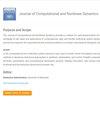Physics Guided Machine Learning Approach to Safe Quasi-Static Impact Situations In Human-Robot Collaboration
IF 1.9
4区 工程技术
Q3 ENGINEERING, MECHANICAL
引用次数: 0
Abstract
Following the performance and force limitation method of the ISO/TS 15066 standard, safety of a human-robot collaboration task is assessed for critical situations assuming quasi-static impact. To this end, impact forces and pressures are experimentally measured and compared with limit values specified by ISO/TS 15066. Consequently, such a safety assessment must be repeated whenever something changes in the collaborative workspace or the task, which severely limits the flexibility of collaborative systems. To overcome this problem, in this paper a physics guided machine learning (ML) method for prediction of peak impact forces, within predefined modification dimensions of collaborative applications, is proposed. Along with a pose-dependent linearized model, an ensemble of boosted decision tree (BDT) in combination with a feed-forward neural network (NN) is trained with peak impact forces measured at a UR10e robot covering the range of interest. A generic pick and place task with two modification dimensions is considered as an example of the presented methodology. The method yields the maximal safe impact velocity in the collaborative workspace.人机协作中安全准静态撞击情况的物理引导机器学习方法
按照 ISO/TS 15066 标准的性能和力限制方法,在假设准静态冲击的关键情况下,对人机协作任务的安全性进行了评估。为此,要对冲击力和压力进行实验测量,并与 ISO/TS 15066 规定的极限值进行比较。因此,只要协作工作区或任务发生变化,就必须重复进行这样的安全评估,这严重限制了协作系统的灵活性。为了克服这一问题,本文提出了一种物理引导的机器学习(ML)方法,用于预测协作应用中预定义修改维度内的峰值冲击力。除了与姿态相关的线性化模型外,还使用在 UR10e 机器人上测量到的峰值冲击力对提升决策树(BDT)和前馈神经网络(NN)进行了训练。以一个具有两个修改维度的通用取放任务为例,介绍了该方法。该方法得出了协作工作区的最大安全冲击速度。
本文章由计算机程序翻译,如有差异,请以英文原文为准。
求助全文
约1分钟内获得全文
求助全文
来源期刊
CiteScore
4.00
自引率
10.00%
发文量
72
审稿时长
6-12 weeks
期刊介绍:
The purpose of the Journal of Computational and Nonlinear Dynamics is to provide a medium for rapid dissemination of original research results in theoretical as well as applied computational and nonlinear dynamics. The journal serves as a forum for the exchange of new ideas and applications in computational, rigid and flexible multi-body system dynamics and all aspects (analytical, numerical, and experimental) of dynamics associated with nonlinear systems. The broad scope of the journal encompasses all computational and nonlinear problems occurring in aeronautical, biological, electrical, mechanical, physical, and structural systems.

 求助内容:
求助内容: 应助结果提醒方式:
应助结果提醒方式:


